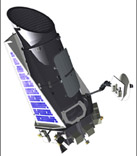
Scheduled to launch sometime after March 5, 2009, the
Kepler spacecraft is the latest telescope to look for exoplanets – planets
outside of our solar system. Since 1995, astronomers have detected about 330
exoplanets. Kepler’s mission, however, will be to find one particular type of
planet – Earth’s twin – one “with a similar size, orbit, and neighbouring star.”
Specifically, the planet should be small and rocky and be orbiting a sun-like
star. And because many scientists believe that liquid water is necessary for the
formation of life, the planet should be at a distance from its star where water
could be maintained on the surface.
The largest telescope to ever leave our orbit, Kepler will be “monitoring
100,000 stars along the Orion spiral arm of our Milky Way galaxy continuously
and simultaneously.” For proper confirmation of the existence of planets, Kepler
will be spending 3˝ years looking at that region of space. Most of the stars
being observed will be from 600 to 3000 light years from planet Earth, one light
year being about 10 trillion kilometers.
While it would be neat to imagine life (like us) on a planet just like ours
somewhere out there in the distances, we should not limit our searches or our
imagination when it comes to intelligent life. Looking at the staggering
diversity on our small planet alone, we have barely begun to imagine what
diversity our galaxy and the greater universe may hold. Nor should we limit life
or intelligence to the forms that we are used to in our tiny corner of the
galaxy. The truth is that we know little of what may exist beyond our solar
system, what forms it may take and what forms of subsistence – known or unknown
– may be requisite for its formation and subsequent continuation.
What will we find? Who knows? Before the discover of the 300 odd exoplanets
since 1995, not many people thought it possible to find the types of planets
that have been found so close to their stars. The only limits to possibilities,
it seems, are the limits in our minds.